Entries from September 2010
September 21st, 2010 · No Comments
I’ve really enjoyed the religion component to this course. Although I don’t believe in organized religion, I’ve never dismissed knowledge about other religious customs and beliefs. However, when visiting famous sites like The Westminster Abbey and St. Paul’s Cathedral, which do attract large masses of tourists, I felt as if I was in a museum rather than a place of worship. Westminster Abbey did have the occasional moments of silence for visitors to remember that it was a religious establishment, however I still didn’t really feel the connection. While I do understand that of course, these beautifully crafted structures are world renowned, if I was religious I would feel a little uncomfortable with a church being more of an attraction than anything else. Visiting St. Paul’s and Westminster did not provide me with any religious education however, when I visited Bath Abbey they did hand out pamphlets that highlighted the importance of God in our lives and bible scriptures, which I appreciated and thought that the other establishments could have done the same.
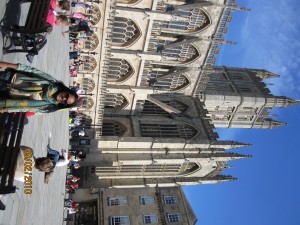
My favorite visits were to the Hindu mandir and the Islamic mosque because I really gained valuable knowledge. Although the mandir also seemed like a tourist attraction, in addition to showing off the intricate details of their temple, they also made efforts to teach the public about their beliefs with providing the exhibition on Hinduism. The mosque wasn’t touristy, but our guide was helpful in explaining his religion and did his best to make connections between what we already knew and contrasted his views to some of our own religions. What I enjoyed hearing about the most was how involved these establishments were in their communities. I think it is great that they participate with people of other faith to reach out and service the community. The mosque’s involvement in TELCO (The East London Communities Organization), which has a commitment to “working together for common good and changing the way politics happen in London”, was one of the many ways that they contributed to their neighborhood.
I found the guide of the mosque to be the most interesting out of all of our visits because he shared something that I have never a representative of any religion say; he admitted that his people suffered from a lack of knowledge about other people’s faith. He shared that there are some people who think they know all there is to know and don’t seek additional knowledge and in his opinion this contributes greatly to the barrier between the Islamic people and the rest of the world. His honesty was admirable and I strongly agreed with him. Something as small as seeking basic understanding of other peoples and religions really can go as far as changing the world one day.
Tags: 2010 Melissa
September 21st, 2010 · No Comments
It took me quite a while to get around to investigating the parks in London. I think most of this is because I had already been to Hyde Park when I was younger (i.e. less interested in such things) and because I was trying to go to so many museums and city-related destinations that I didn’t really think I had the time. Another unconscious reason, I suppose, is that, while I do love Central Park, I just didn’t really think that parks in the middle of a city would be much to write home about. But I was wrong.
While getting caught up in the crowds and the bustle of the city, I completely forgot to, literally, stop and smell the roses- if you’ll forgive the pun. I know everyone I spoke to on the subject had the same experience, but it truly is amazing to walk a few minutes away from the city and find yourself completely surrounded by green. Kaitlin and I decided to get some take away from Harrod’s and bring it to Hyde Park to eat, and we walked straight out of the city and into the rose gardens. (First we had to pass a horse riding trail. It was amazing!) Once you travel farther into the park, it’s even easier to forget that Harrod’s and Knightsbridge are only a few kilometers away.
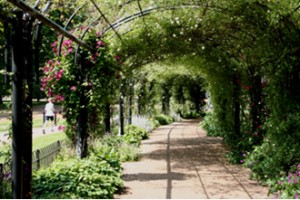
Hyde Park Rose Garden (courtesy of GardenVisit.com)
Hyde Park – photo courtesy of GardenVisit.com
And Regent’s Park, that’s another story entirely. We got off the tube, walked down an upper class residential street, and wound up in what seemed like an entirely different part of the country. With playgrounds, huge green fields, trees, ponds, rose gardens, and high hedges, it is entirely possible to forget that you are in a huge, busy city.

Regent’s Park – photo courtesy of GardenVisit.com
I know it sounds pretty cliché, but it really was fantastic to get back in touch with nature after so seeing much brick and stone day after day. I could have sat and watched the swans swim and stare at the flowers all day. Unfortunately I was only able to spend a few hours in the parks, but it was an amazing diversion from busy city life. And today at Hampstead Heath was completely gorgeous. Some of the girls and I had to take the time to frolic through the fields because we’ve missed nature so much.
Even though I initially dismissed the importance of the parks in London, I loved seeing so much green in the middle of the buildings. And because there aren’t so many skyscrapers in London, it was much easier than expected to forget I was in the city at all. No traffic noise, no pollution, no impatient drivers or pedestrians; just nature, for as far as I could see.
Tags: 2010 Jessica
September 21st, 2010 · 1 Comment
It seems like everyone I talked to in our program strongly disliked the Victoria and Albert Museum. I don’t know what they were thinking, because I thought it was one of the most amazing places I have ever been. I loved how random it was – it really epitomized British eccentricity. The V & A seemed to be completely lacking in order from one room to the next, whereas other museums that we have been to, like the British Museum or the London Museum seem to be arranged more logically. But I really like how chaotic it was. It added the element of surprise which made me laugh aloud. I think the key is to go in with a game plan. Know which exhibits you want to see beforehand, that way you organize your visit accordingly. Any interesting sites you find along the way can just be a fun little bonus.

So what was the most interesting part of such a fascinatingly bizarre place? No, not the jewelry, although my eyes were glued to several dazzling tiaras, but what I found most intriguing was being able to watch the museum staff put together an exhibit. I felt like I was backstage at a play, watching the people who work behind the scenes. I never realized how much work it would take to create even just one exhibit. There were at least ten or fifteen people working on the room. Some were doing physical work, lifting and moving planks of wood, while others looked over papers on clipboards and directed traffic. However, I was a bit mystified because I didn’t know what it was exactly that they were building and I still don’t know what it had to do with that particular room of the museum. It just looked like they were plonking down a big ol’ wall in the middle of the room. And as far as I could tell there were no signs posted anywhere with “coming soon” information, so I’ll just have to make another trip back to London in a few months to see what it looks like.
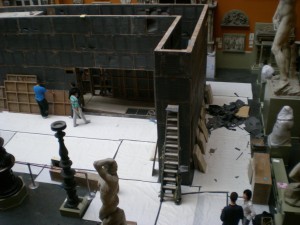
I also got really excited when I saw the piece by Dale Chihuly. The artist is known for his work with glass, creating huge and intricate structures. I was fortunate enough to be able to see his exhibit back home at the Botanical Gardens in New York with my family, and so when I recognized his work in the V&A, it was like seeing a little piece of home.

This is a piece at the Victoria and Albert Museum
Here’s one from home:

Tags: 2010 Sarah
September 21st, 2010 · No Comments
From what I’ve begun to gather, the English (or, Londoners) aren’t particularly fond the French or French culture. I overheard a conversation on the street that ended in, “Do I look bloody French to you?”. Not quite sure of the motivation behind the outburst, but anti-French sentiment, while not rampant, is a visible part of popular English culture. It’s strange, then, that some of London’s most prominent physical elements should mesh so completely with the French formal ideal: parks.
The classic French conception of beauty in nature is that none can exist without the existence of order- of the human hand altering the chaotic natural mass into a structured, geometric product. From what I’ve seen of the layout of Regent’s park, the Brits have just about the same idea. Many people have commented that parks in London seem to be, first and foremost, places to enjoy the beauty of the precisely-planned horticulture. We see meticulously trimmed hedges, flowers planted with regard to color scheme, and white fountains as centerpieces. While running in Regent’s the other afternoon, I saw teams of gardeners replacing soil and adjusting flowerbeds. The beauty lies not only in pure nature, but in the reordering and distribution of it.

http://www.gardens-to-visit.com/2009/02/versailles-2.html
It’s hard to think of a better example of this systematic restructuring than in Versailles. The hedges are pruned to an almost impossible degree of uniformity, the flowers are separated with care, and there are man made monuments throughout (to serve as an even more solid testament to the strength and genius of the designers. The same artistic values and technical skill are visible in Queen Mary’s Garden in Regent’s park.
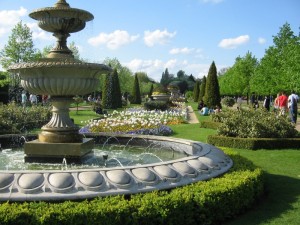
http://www.londonrelocationservices.com/blog/tag/west-london-relocation
The rows and rows of flowers in the garden do not grow in natural patterns, as might be typical in American parks or gardens. Like their French counterparts, the English gardeners have devised color schemes, strict rows, and tight upkeep standards on all the elements of the space (note the uniformity in the hedges around the fountain and the flower patches). These areas of the park are not meant for “fun” in the typical American park sense of the word- we were glared at for tossing a frisbee in the garden a few days ago. They’re a medium of artistic expression, and I’m starting to appreciate them more and more. I do think, however, that instead of badmouthing the French, Londoners should take some time to stop and smell the roses. It’s through these gardens that we can see real, fundamental similarities in an important aspect of the two cultures.
Tags: 2010 Patrick · Uncategorized
September 21st, 2010 · No Comments
The parks of London provide a natural respite from the busy, hectic, and stressful atmosphere of the city. Once in them, you are enveloped by a green tranquil, unable to hear the bustle of cars and people outside the parks’ confines. I have personally experienced this phenomenon at several parks, ranging from Regent’s park (where I ran for the first time since surgery! not a bad debut location), Hyde Park, and most others. This type of division between hustle-bustle and repose mirrors the separation of work and play that Fox often talks about.
However, there is also a clear division within the park of activities that mirrors this division of social and work life. There are areas for sitting contemplatively in very silly chairs, which you are supposedly required to pay for. There are areas for looking at quite nice fountains, sculptures, or gardens. Then there are designated areas for sports, with soccer nets and rugby… posts? Tennis courts seem a bit necessary to be fenced off for convenience’s sake. Several little cafés are sprinkled throughout the parks as well.
Regent’s park matches the above description. I’ve made several trips to this park to run, play a bit of ultimate, have a cup of coffee, or just stroll around and look at the great horticulture. However, all of these activities would occur in different locations in the actual park. This segments the activities, and consequently divides the people that enjoy different forms of recreation. Personally, it made me very uneasy. If I were to throw a disc in the wrong area, I risked getting publicly reprimanded (as classmates have experienced). Anyway – it would take quite a bit of time for me to analyze this division (and I really don’t have the experience or expertise to do so) but there has to be some sociological effect. If you have thoughts on this, just comment on this post.
However, not all parks match this model. St. Jame’s park, home of many venereal diseases during the restoration period, per Dennis’ description, is seemingly built for nothing but comfort and relaxing. There are nice little walks along the lake, a couple bridges, some out-of-place fowl, and many large grassy areas upon which you can sit. However, in a couple walks through the park, I never saw anyone playing catch, football, or any other sport in these large areas. Though it was suspiciously absent of proper monuments (at least, I didn’t see many), the website is careful to highlight the pelican feeding from 2:30-3, and the deck-chairs. Weird. More leisure activities. I should note that there is a quite disproportionately small playground for children. However, as a whole, this is not a built-for-fun park. It is a built-for-relaxing-park, and I think is such because of its close proximity to Buckingham Palace. Green Park, also bordering Buckingham Palace, mirrors this model of relaxation, rather than recreational, with a few monuments (such as the Canada memorial), and is a bit more open green spaces rather than pathways-and-lakes. To me, these two parks are just not okay. I envision parks as a place where you can run around, play whatever kind of games you want. Having fancy gardens in parks just seems to counteract this.
Hyde park, the last park I will discuss in this post, blends athletics and relaxation much like Regent’s. And, just like Regent’s, different activities are segmented. There are different areas for sitting in lawn chairs, areas for tennis, I’ve seen people playing soccer on some of the larger fields (quite far away from the chairs, mind you), and the notorious Speaker’s Corner, completely ostracized from any central location. I suspect that its location is completely intentional whatever authority governs the parks wanted to make sure the… colorful characters that frequent the corner would not pollute (in their mind) the rest of the park.
Well, the parks are divided not only from the city but often divided within themselves. What effect this has on the psyche of park attendees, I’m not sure. Though I love the idea of having large parks in cities, I don’t like this division. If you want to have fancy gardens, just don’t call the whole thing a park.

 That these two photos (both personal) came from the same park (Regent’s) makes little sense to me (though the picture from the right, in my opinion, should not even come from a park).
That these two photos (both personal) came from the same park (Regent’s) makes little sense to me (though the picture from the right, in my opinion, should not even come from a park).
Tags: 2010 ChristopherB
September 21st, 2010 · 1 Comment
Sarcasm (n): harsh or bitter derision or irony; a sharply ironical taunt; sneering or cutting remark. For the English, the national language- my addition.
It says something interesting about a nation when strangers make sarcastic remarks to you to indicate that they are trying to be friendly. In fact, the first time I truly felt welcome in London was when an older English gentleman made a silly, sarcastic remark to me at the Discover Greenwich museum. Another interesting thing is that the English seem to think that they have cornered the market on sarcasm.
Jesse was taking a picture of me wearing a replica of a jousting helmet- the tag said “try me on!” and you don’t need to tell me twice- when the man apparently said, “Well, that’s an improvement!” As there was essentially a snug metal bucket on my head, I couldn’t exactly hear him, so Rachel repeated it to me after I took the helmet off. When I smiled at the man and said, “You’re probably right about that,” he grinned back and explained that he was “only joking.” This event made me ecstatic and I bounced around to all my friends, telling them that I was starting to fit in in England.

This is an improvement...
Shortly after, when we needed directions to the tunnel that runs under the Thames, we asked the docents at the museum. They seemed eager to direct us toward the tunnel and added that “the tunnel doesn’t usually flood and people rarely ever die in it.” We laughed along with them, but they continued to act as if we must have no idea that they were joking. We’re Americans and therefore must not understand sarcasm. Because our country is entirely full of earnest people, right? (Wink wink, nudge nudge…)
I find it very interesting that- and this is a huge generalization- for a nation of overly standoffish people, the English sure love their sarcasm. It seems odd to me that no one makes eye contact on the street or on the tube, but it is totally acceptable to poke fun at a stranger at a museum.
Even though this probably sounds like a criticism, don’t get me wrong: I’m totally fluent in sarcasm, too.
Tags: 2010 Jessica
September 21st, 2010 · 1 Comment
There’s a crazy wide variety of theatres in London, more than I’ve ever experienced in one place before. Sure, it’s a little bit annoying to stand up for 3 hours while watching a play, but when am I going to have the experience to lean on the stage of a theatre, except when I’m at the Globe? And when am I going to get to see big name shows like Les Mis and Wicked one night and brand new shows like Deathtrap and Bedlam the next?
Theatre is so different here than in the US. In the States, theatre is very elitist. Tickets are so expensive that it’s hard for the medium to be accessible to everyone. Here, because the tickets are cheaper, it’s much easier for everyone to go out to the theatre much more frequently. We showed up yesterday morning and got 25 pound front row seats for Deathtrap. We were so close we could see Jonathon Groff spit (although I’m fairly certain everyone could see that). Because people can get such cheap tickets so frequently, many people- of many different social and economic backgrounds- are all so accustomed to going to the theatre. This results in the delightful traditions we witnessed at places like the Royal Albert Hall; symphony-goers starting a slow clap during intermission and coughing loudly between movements and the like.
To read a little more about these traditions, check out this site: http://www.independent.co.uk/arts-entertainment/classical/features/how-the-proms-turned-populist-without-offending-the-purists-2040031.html.
Part of the reason that theatre here is so accessible is that the UK makes an effort to get people out to the theatre. Right now there is program running called A Night Less Ordinary, which offers free tickets for over 200 of the subsidized theatres in England to residents under the age of 26 (http://www.ukstudentlife.com/Life/Entertainment/Theatre/Tickets.htm). It’s amazing to me that the government would offer free theatre tickets. In the states, that would be unheard of.
Here, theatre is a bit of an equalizer. A college student like myself can pay 15 pounds (or, in our case, have the school pay our 15 pounds) to go to the National Theatre and sit 10 seats away from Sir Ian McKellen (true story, folks)! And if you don’t mind sitting in the back row of the Apollo Victoria or the Barbican, you’ll end up paying as much as you might pay for a mediocre dinner to go see a West End show.
The accessibility of the theatre seems to foster a love of the theatre in this country. To me, government subsidized tickets for young people make perfect sense. Get ‘em hooked, and they’ll keep coming back for more, something that is apparent when you look at the audiences here. Every show is practically packed, at shows that have been running for 2 months and ones that have been running for 20 years.
And, did I mention how fun it is to meet the actors after the low-priced performances?:

Not too shabby, eh?
Tags: 2010 Jessica
September 21st, 2010 · No Comments
I really don’t have anything academic or insightful to say about pubs, so I’ve been holding off on this post. I haven’t visited too many pubs in London because there were other things that I wanted to do instead, like going to see various theatre shows. I also don’t like beer, so the discovery of cider has been a lifesaver. I’ve been to quite a few pubs for lunch, actually, which is a completely different experience than going for drinks at night. In the afternoon the pubs aren’t nearly as crowded, but I felt like more suspicion fell on me as an Outsider then. The room is quiet enough that my American accent is very apparent, and everyone can hear my akward attempts to order food and, in the beginning of our trip, to count out the proper change. I don’t know all of the social cues yet (not that the British are very helpful in this aspect), and I feel like people definitely watch me and judge that. This might be a bit paranoid, granted, but I clearly don’t belong, and it can be an uncomfortable experience.
This contrast really comes to mind when I think of The Court–I went once for lunch and once for drinks with a large group. At lunch everyone could hear us as we debated the menu, and the bartender looked at me as if I was an idiot when I said, “Can I please try…” I’m sorry, I worked in retail for three years, and it’s hard to break that false cheerfulness during cash register interactions. But when I went back at night, the atmosphere was completely different. Both floors were crowded, there was loud music playing, and there was much more energy about the place. I really liked The Court for that type of outing–I wanted to have fun with my friends and drink a little more than I needed to, and I feel like The Court offered a really comfortable atmosphere for that. There were so many young people there that I could be sure that a) no matter how loud we got, the group next to us was drinking way more and being much louder than we were, b) someone would try to make conversation when I was waiting at the bar to order a round, c) the bartender wouldn’t have time to notice my awkwardness in ordering said round, and d) I could sing Journey at the end of the night without anyone caring, because they couldn’t really hear me. Would I like this atmosphere every night? Absolutely not. But for going out with friends, I thought that it had a really fun place.
This preference would probably make George Orwell turn over in his grave. His description of the ideal pub in “The Moon Under Water” sounds absolutely nothing like The Court. The exact opposite, in fact. I can see where Orwell was coming from, however. His pub is quiet, with good conversation and good beer served in the proper mugs. Based on what we’ve read in Kate Fox, pubs are a huge center of British culture, and it seems to be where people can go to forget what else has happened in the day and just socialize with other regulars. The familiarity becomes comforting in and of itself. For that purpose, I wouldn’t want to go to The Court either. Maybe this is one of the reasons the English have a pub (or sometimes more) on every corner, because each pub serves a slightly different purpose and attracts a slightly different crowd.
Tags: 2010 Holly · Pubs
September 21st, 2010 · 2 Comments
After visiting Hamstead Heath with a friend from London, she took me down Bishop’s Avenue which she claimed to be the most expensive street in London. Bishops Avenue is in Hampstead, a wealthy areaof Northern London. On it are some of the largest, and strangest, houses in London. After doing a bit of research I found out that the Avenue is known not necessarily for being London’s most expensive residential road (though it is in the top three) but it certainly has the largest number of huge, empty houses
The attraction of owning a house on this road is purely prestige. The neighborhood is a fifteen minute drive from central London, can have a garden of a couple of acres, and is only thirty minutes from London Luton airport, the obvious choice for owners of private jets. There are plenty of other wealthy areas of London, the 16th most expensive city to live in as of 2009 (3rd in 2008, according to the Guardian: http://www.guardian.co.uk/news/datablog/2009/jul/07/global-economy-economics). Arguably, none of the other wealthy neighborhoods or streets carry with them the same nouveau riche implications that Bishops does.
There’s the famous Kensington Palace Gardens street , owned and leased by the Crown and with gates at either end, it is currently the most expensive road per square foot in London.
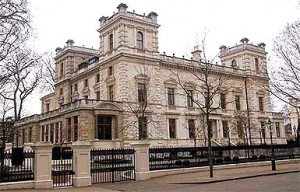
http://www.propertyinvestmentproject.co.uk/blog/most-expensive-house-in-the-world/
However, Bishops Avenue lays claim to the highest concentration of giant, super-expensive houses. It has another distinction: it is here that the Saudi royal family bought seven homes in the early 1990s when they thought that Sadam Hussein would invade their country (see below Times article). All of those houses are now unoccupied as are a huge proportion of the mansions on Bishops Avenue. In fact, they are occupied so rarely that owners sometimes find squatters inhabiting their homes when they stop by once every five years or so.
As a piece in the times points out, these houses are owned not by people for whom money is no object but by those for whom it is the only object (Times). People who have purchased these houses are interested in the status which comes with owning a piece of property whose exact monetary value is frankly beside the point.
When it was purchased in 2004 and renamed the Royal Mansion, the $50 million Toprak Mansion, held the distinct honor of the most expensive new house ever sold in London. It now has giant gold lettering across the top of the columns proclaiming its new name for all to see.

http://news.bbc.co.uk/1/hi/in_pictures/7208534.stm
http://www.dailymail.co.uk/news/article-510744/The-Chavenue-Inside-expensive-road-London.html
Britain’s richest man, Lakshmi Mittal, also owns a house here which he has been unable to sell. Instead, he has offered to rent it for the paltry sum of 10,000 pounds-a-week.
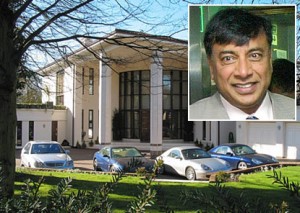
http://www.thisislondon.co.uk/standard/article-23725446-mittal-rents-out-10000-a-week-palace-he-cant-sell.do
There are many remarkable, and shocking, things about the culture of opulence which these houses represent. I’ll leave you with this from the Times:
“I heard a story, a parable even, about this pocket of north London. It takes place in the plant room of a new-built mansion – where else? – and concerns a certain country’s richest man, whose identity I promised to conceal for fear of my informant’s social (and, perhaps, actual) death. This man and his wife had not lived in their house for long – one of the world’s most expensive – when the heating systems began to go awry. Now, when you live in a 20,000-square-foot house and the plumbing’s playing up, you call someone fast. The engineer arrived promptly, went down to the plant room and looked at the series of mechanical control panels that monitor the byzantine complex of boilers and water tanks and filters. And they were all to cock. Someone had been messing around with them. He asked around the staff, but nobody knew anything about it. Eventually the owner’s wife admitted, rather sheepishly, that she had been in the room and had tried to adjust the settings. Why, asked the engineer. Her reply tells you everything you need to know about this odd little world. “I was worried about the heating bills,” she said.”
Cited:
http://property.timesonline.co.uk/tol/life_and_style/property/article4164403.ece
http://property.timesonline.co.uk/tol/life_and_style/property/overseas/article4632834.ece
Tags: 2010 Daniel
September 20th, 2010 · 2 Comments
I like the way in which Orwell describes both his favourite and ideal pub, citing that those are two different ideas and, that as good as The Moon Under the Water is, it does not entirely meet his ideal setting criteria. I think his pragmatism is admirable, therefore I have differentiated my ideal criteria from the pub that takes the number one spot on my list that I’ve visited during the past four weeks.
Here are my criteria:
1. Football. Every good pub needs to have the match on. There is nothing that lends itself more to a pub than football. All the elements of a pub: beer, argument etc. are present in a football match. I have a great suspicion that sole reasons pubs have flourished throughout English history; but, as of yet, I lack evidence to support that claim.
2. Pub Quiz. Every good pub should have a weekly pub quiz. The level of seriousness and competitiveness may vary, but there should be a weekly quiz nonetheless. Also, the pub needs to have a quiz master that takes the quiz more seriously than their job, and this is mandatory. In order for this trivia quiz to appear to have any significance in the lives of the pub regulars, the questions asked must be presented by the quiz master with the illusion that they are of endless importance to our human existence. One can always tell how the quiz master has prepared for each quiz. The recommend time is 18-20 hours a day, all week.
3. Sunday Roast. A Sunday roast is a cherished English tradition and every good pub should take it on as a priority. Mmmm … Yorkshire puddings.
4. The pub’s fish ‘n should be made with cod. Ok, I have nothing against haddock. It is a fine fish I’m sure; but, I think parliament should consider making a national law making mandatory for haddock fish ‘n chips to be CLEARLY stated on all pub menus. Words cannot express the disappointment in ordering fish ‘n chips and having haddock arrive on your plate … tough break oh-ten.
5. Drink specials, specifically 4-pint pitchers. For those of us that are a bit new to the rounds-buying system of buying drinks in pubs, pitchers make things a bit easier, as well as save you a few quid.
6. No live DJ. DJ’s are alright, but what they’re really trying to do is turn a pub into a nightclub. I’m not down with that.
1. During my brief stay here in London, I have lacked sufficient time to judge each of the many pubs I’ve been to by all of these criteria. However, I do have a favourite. The Rising Sun, on Tottenham Court Road, has become my go-to pub to watch a football match, and for this reason, it probably takes my top spot. Also, the show their games on Sky Sport 3D, and for a five quid deposit, you can get glasses to watch the match in 3D (Ok, I’ll admit, like any football purist, I scoffed at this idea at first, but after watching a 4-0 England rout of Switzerland in 3-D, I’m a believer). The Rising Sun also offers pitchers that save you a few pounds here and there and they do well about steering clear of the problematic diversions, such as DJs that could damage the atmosphere of the pub. The Rising Sun is not a place to spend a night out on the town getting wasted, but rather it is a great place to have one or two pints, and, if you’re lucky, check out the footy.
2. The second on my list is The Court. The Court consists of a pool table, perhaps the best pitcher deal in the Bloomsbury area and a group of regulars that seem to have a decent taste in music. Operated by a public juke box, The Court gains major points for a patronage that put 2 Bowie songs in a row, Prince, Otis Redding and Earth Wind and Fire all in a night. Well done.
3. Third is The Rocket. Quality deals on bottles of Becks, and Newcastle Brown Ale is never out of stock. This pub offers later hours on weekends (2am) on Thursdays and weekends for the later crowd. Thursday night live DJ threatens to ruin the atmosphere, but the he is pretty chilled out, realizes that he’s not DJing at a club and generally plays what people ask to hear.
4. The last spot on my rankings, gaining an Honourable Mention, is The Bank of England. My most recent pub experience offers great porter and a classy, elegant night out to the pub. Decorated very luxuriously, The Bank of England makes it into the top four by means of a very positive first impression. Not much on the drink specials, but its understated elegance, no music and great ale selection make no muddle of defining The Bank of England as another shining example of the “proper pub.”
Tags: 2010 Luke
















